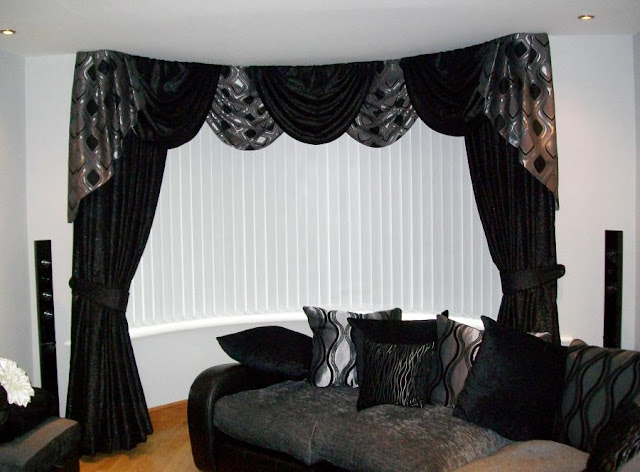Swags
 |
| Valances, Cornices, Swags (Swags) |
A swag or draped valance should be made of a material that drapes
easily, as it is a formal treatment. A silk or taffeta is good. It may be lined
in the same fabric or in a contrasting color, as the lining will show in some
folds. It is made in three sections, and it is best to start with the center
section. Cut a straight piece of muslin the width of your window and 36 inches
deep at the center. Curve the bottom gently so that it is wider than the top.
Drape it on the valance board and tack it in place, or place it on a table and
arrange the folds, tacking them down with pins. Study the effect; if you want a
deeper drape, adjust it accordingly.
Sides for the swag are made by cutting a piece of fabric, widening
it 4 inches on each side to its widest point and narrowing at the bottom, 30
inches from the center of the top width. Such a piece will make two sides. Cut
a piece of lining of the same size and dimension as the drapery fabric and
place the two fabrics, right side down, on it ready for sewing. Stitch all
around the piece, but not across the top width. At this point, you will have a
bag-like piece of fabric, coming to a point at the bottom but open at the top.
Now, starting from the center of the top, the open part, cut the entire piece
in half, down through the point. You now have two sides. All that remains to be
done is to slip stitch the top portion closed, leaving what was the center of
the larger piece open. Turn right side out, fold in the appropriate folds, and
hang by tacking to the valance or cornice board. You can get varied effects
depending on whether or not you wish to press your swag.
 |
| Valances, Cornices, Swags (Swags) |
Trimmings for valances and swags, as well as for curtains and
draperies, are available in a wide assortment of fabrics and styles. Your
choice naturally depends on your curtain or drapery style, your fabric, and
your room. As with valances, tassels, braid, fringe, and other elaborate forms
only recently thought to show old-fashioned bad taste, trimmings have suddenly
become high style in some quarters, and stiff valances with gold braid,
applique in metallic thread, and fringe in bold colors are seen in many period
rooms and, if anything, are even more ornate than in the past. In addition, you'll
find such ambitious treatment as pleating of contrasting color shown under
draped valances.
More conservative trimmings such as glazed chintz piping, coarse
cotton-looped fringe, striped cotton braiding, and cotton ball trim are always
good however and, in contrasting color, pick up and accent the lines of
draperies and the colors of fabrics in much the same way that a black line will
sharpen and improve a painting.




